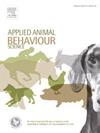Feeding behavior quantification and recognition for intelligent fish farming application: A review
IF 2.2
2区 农林科学
Q1 AGRICULTURE, DAIRY & ANIMAL SCIENCE
引用次数: 0
Abstract
Experience-driven manual and mechanical feeding often fail to accurately address fish appetite needs in aquaculture. Analyzing the relationship between fish behavior and feeding activity through efficient modeling to develop intelligent feeding systems is a key challenge in current research. In this regard, computer vision has emerged as an effective tool for behavior analysis due to its cost-effectiveness and non-invasive nature. Based on this, this paper provides a comprehensive review of the research progress in applying computer vision to fish feeding behavior analysis and its practical implementations. Firstly, this study introduces the key indicators reflecting fish feeding states. Subsequently, we summarize and discuss the critical methods developed in recent years for quantifying and recognizing fish feeding behavior using computer vision. Additionally, the paper consolidates and analyzes case studies of intelligent feeding applications based on these methods. Finally, based on current research advancements, this paper highlights four key challenges future directions for intelligent feeding technology, including real-time performance, stability, efficiency, and fish welfare. The goal of this work is to offer a scientific foundation and valuable reference for the development of intelligent feeding systems in aquaculture, while also inspiring further reflection and exploration among researchers.
饲料行为量化与识别在智能养鱼中的应用综述
以经验为导向的人工和机械饲养往往不能准确地满足水产养殖中鱼类的食欲需求。通过高效建模分析鱼类行为与摄食活动之间的关系,开发智能摄食系统是当前研究的关键挑战。在这方面,计算机视觉因其成本效益和非侵入性而成为行为分析的有效工具。在此基础上,本文综述了计算机视觉在鱼类摄食行为分析中的研究进展及其实际应用。本研究首先介绍了反映鱼类摄食状态的关键指标。随后,我们总结和讨论了近年来利用计算机视觉量化和识别鱼类摄食行为的关键方法。此外,本文还对基于这些方法的智能投料应用案例进行了整合和分析。最后,结合目前的研究进展,提出了智能投喂技术在实时性、稳定性、效率和鱼类福利等方面面临的四大关键挑战和未来发展方向。本工作旨在为水产养殖智能饲养系统的发展提供科学基础和有价值的参考,同时也启发研究者进一步的思考和探索。
本文章由计算机程序翻译,如有差异,请以英文原文为准。
求助全文
约1分钟内获得全文
求助全文
来源期刊

Applied Animal Behaviour Science
农林科学-行为科学
CiteScore
4.40
自引率
21.70%
发文量
191
审稿时长
18.1 weeks
期刊介绍:
This journal publishes relevant information on the behaviour of domesticated and utilized animals.
Topics covered include:
-Behaviour of farm, zoo and laboratory animals in relation to animal management and welfare
-Behaviour of companion animals in relation to behavioural problems, for example, in relation to the training of dogs for different purposes, in relation to behavioural problems
-Studies of the behaviour of wild animals when these studies are relevant from an applied perspective, for example in relation to wildlife management, pest management or nature conservation
-Methodological studies within relevant fields
The principal subjects are farm, companion and laboratory animals, including, of course, poultry. The journal also deals with the following animal subjects:
-Those involved in any farming system, e.g. deer, rabbits and fur-bearing animals
-Those in ANY form of confinement, e.g. zoos, safari parks and other forms of display
-Feral animals, and any animal species which impinge on farming operations, e.g. as causes of loss or damage
-Species used for hunting, recreation etc. may also be considered as acceptable subjects in some instances
-Laboratory animals, if the material relates to their behavioural requirements
 求助内容:
求助内容: 应助结果提醒方式:
应助结果提醒方式:


